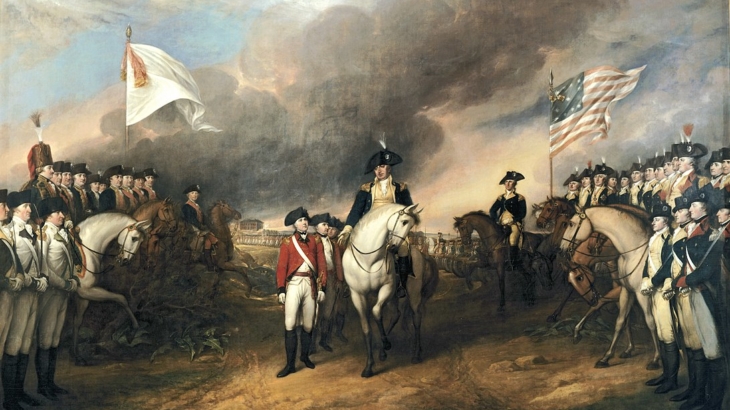October 19, 1781: British Surrender at Yorktown, Effectively Ending the Revolutionary War
The surrender of General Charles Cornwallis to General George Washington at Yorktown, Virginia, was the final battle of the American Revolution. Then, in 1783, the Treaty of Paris was signed after an appeal from the British for peace, and the American Revolutionary War was over.
In 1778, a full three years before his victory at Yorktown, General George Washington wrote: “The Hand of providence has been so conspicuous in all this, that he must be worse than an infidel that lacks faith, and more than wicked, that has not gratitude enough to acknowledge his obligations.”
Washington was not lacking in gratitude; more than once God’s hand of providence had appeared to save his beleaguered army. Whether it was the sudden fog that enveloped the East River in August 1776, allowing his army to safely retreat from the Brooklyn Heights, or the “false spring” nearly two years later that tricked shad into beginning an early run up the Delaware River to Valley Forge, Washington knew whom to thank. But at least one more act of providence lay ahead. On September 5th, 1781, a French fleet appeared providentially to defeat a slightly smaller British fleet, thus preventing the rescue of General Cornwallis and his army from their fortified but surrounded position at Yorktown.
Cornwallis had received conflicting and confusing orders from his commander back in New York, General Sir Henry Clinton, but, like a good soldier, had followed them as he understood them, believing that his exposed position at Yorktown would be remedied, if necessary, by the British Fleet. It was a gamble that unfortunately did not pay off. It did not help the British that their fleet commander, Admiral Thomas Graves, proved indecisive at a critical juncture while the French fleet under Admiral Francois Joseph Paul de Grasse did not let their disadvantaged position exiting the Chesapeake Bay lead to their downfall; the French attacked aggressively and decisively. Historians have called the Battle of the Virginia Capes the most critical naval engagement in history! It is said to have converted “the United States” from a possibility into a certainty.
Cornwallis was embarrassed, to say the least, by being left “flying in the wind” by Graves’ defeat. So embarrassed that after the surrender of his force had been negotiated for October 19th, he cited illness and had his second in command Brigadier General Charles O’Hara surrender the sword instead. In a final attempt to humiliate Washington, O’Hara had been instructed by Cornwallis to present his sword to the French General Rochambeau. Rochambeau politely directed the British officer to Washington who, seeing this, directed his own second in command, General Benjamin Lincoln, to accept the surrender, payback for Lincoln’s defeat the previous year at Charlestown. What games these Generals play. The painting, Surrender of Lord Cornwallis, by John Trumbull is one of the eight large, iconic paintings located in the United States Capitol Rotunda.
There would be more fighting ahead – minor skirmishes at best — but Cornwallis’ surrender “took the wind from the sails” of the British force in America. Two years would elapse before a peace treaty would finally be signed in Paris on September 3, 1783 formally ending the eight year conflict, and nearly three more months before the last British troops boarded ships to leave New York on November 25th, but it was a wait worth enduring.
Nine days later on December 4, 1783, George Washington said goodbye to his Generals, a poignant moment captured in another piece of iconic artwork, Washington’s Farewell to His Officers in an engraving by Phillebrown, from a painting by Alonzo Chappel. “With a heart full of love and gratitude, I now take leave of you. I most devoutly wish that your latter days may be as prosperous and happy as your former ones have been glorious and honorable.”
The General then mounted his horse and turned towards Annapolis, Maryland.
Gary Porter is Executive Director of the Constitution Leadership Initiative (CLI), a project to promote a better understanding of the U.S. Constitution by the American people. CLI provides seminars on the Constitution, including one for young people utilizing “Our Constitution Rocks” as the text. Gary presents talks on various Constitutional topics, writes a weekly essay: Constitutional Corner which is published on multiple websites, and hosts a weekly radio show: “We the People, the Constitution Matters” on WFYL AM1140. Gary has also begun performing reenactments of James Madison and speaking with public and private school students about Madison’s role in the creation of the Bill of Rights and Constitution. Gary can be reached at gary@constitutionleadership.org, on Facebook or Twitter (@constitutionled).
Click Here to have the NEWEST essay in this study emailed to your inbox every day!
Click Here to view the schedule of topics in our 90-Day Study on American History.


 https://en.wikipedia.org/wiki/Articles_of_Confederation#/media/File:Articles_page1.jpg
https://en.wikipedia.org/wiki/Articles_of_Confederation#/media/File:Articles_page1.jpg
Join the discussion! Post your comments below.
Your feedback and insights are welcome.Feel free to contribute!